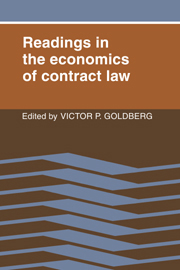Book contents
- Frontmatter
- Contents
- Preface
- Readings in the economics of contract law
- Part I Some preliminaries
- 1.1 Non-contractual relations in business: a preliminary study
- 1.2 Relational exchange: economics and complex contracts
- 1.3 Production functions, transactions costs, and the new institutionalism
- 1.4 The market for “lemons”: quality uncertainty and the market mechanism
- 1.5 A treatise on the law of marine insurance and general average, volume I
- 1.6 The economics of moral hazard: comment
- 1.7 The economics of moral hazard: further comment
- 1.8 Efficient rent seeking
- Questions and notes on rent seeking
- Part II Contract law and the least cost avoider
- Part III The expectation interest, the reliance interest, and consequential damages
- Part IV The lost-volume seller puzzle
- Part V Specific performance and the cost of completion
- Part VI Power, governance, and the penalty clause puzzle
- Part VII Standard forms and warranties
- Part VIII Duress, preexisting duty, and good faith modification
- Part IX Impossibility, related doctrines, and price adjustment
- Questions and notes on impossibility and price adjustment
- References
- Index of cases
- Author index
- Subject index
1.2 - Relational exchange: economics and complex contracts
Published online by Cambridge University Press: 10 November 2010
- Frontmatter
- Contents
- Preface
- Readings in the economics of contract law
- Part I Some preliminaries
- 1.1 Non-contractual relations in business: a preliminary study
- 1.2 Relational exchange: economics and complex contracts
- 1.3 Production functions, transactions costs, and the new institutionalism
- 1.4 The market for “lemons”: quality uncertainty and the market mechanism
- 1.5 A treatise on the law of marine insurance and general average, volume I
- 1.6 The economics of moral hazard: comment
- 1.7 The economics of moral hazard: further comment
- 1.8 Efficient rent seeking
- Questions and notes on rent seeking
- Part II Contract law and the least cost avoider
- Part III The expectation interest, the reliance interest, and consequential damages
- Part IV The lost-volume seller puzzle
- Part V Specific performance and the cost of completion
- Part VI Power, governance, and the penalty clause puzzle
- Part VII Standard forms and warranties
- Part VIII Duress, preexisting duty, and good faith modification
- Part IX Impossibility, related doctrines, and price adjustment
- Questions and notes on impossibility and price adjustment
- References
- Index of cases
- Author index
- Subject index
Summary
We begin with an obvious empirical fact. Much economic activity takes place within long-term, complex, perhaps multiparty contractual (or contract-like) relationships; behavior is, in varying degrees, sheltered from market forces. The implicit contract of utility regulation, the contractual network that constitutes a firm, franchise agreements, pensions, and collective bargaining agreements are examples. Granted this, we can then proceed along two different lines. First, we can attempt to explain why relationships take the form that they do; why does a particular firm own its retail outlets rather than selling through franchised outlets or discount stores? Second, what impact does the relationship's structure have beyond the relationship? Do the price adjustment rules used in employment contracts or in regulated industries give the wrong short-run signals, thereby exacerbating unemployment? Since economists attempt both to explain and prescribe, these questions can also be recast in normative terms: How should parties structure their relationships (from the point of view of the parties or other groups – perhaps society as a whole)?
To make headway in understanding the essential features of relational exchange it is convenient to set up a stylized problem. Consider two parties contemplating entering into a contract who must establish rules to structure their future relationship. The parties can have competing alternatives both at the formation stage and within the relationship. The choice of rules will depend upon the anticipated outcomes. The choice will also reflect three significant facts about the world that are so obvious that only an economist would feel compelled to recognize them explicitly.
- Type
- Chapter
- Information
- Readings in the Economics of Contract Law , pp. 16 - 20Publisher: Cambridge University PressPrint publication year: 1982
- 1
- Cited by



